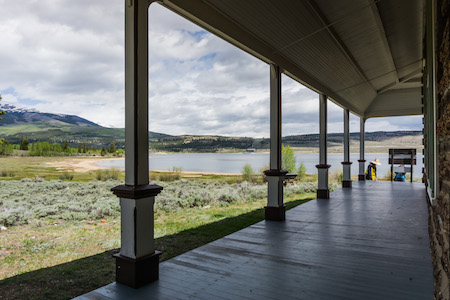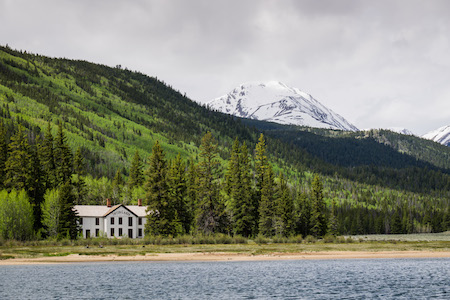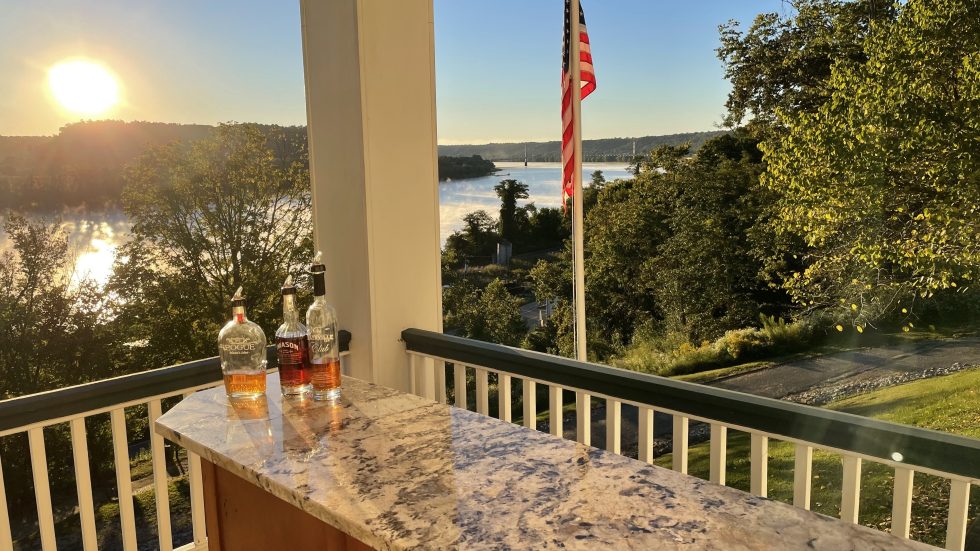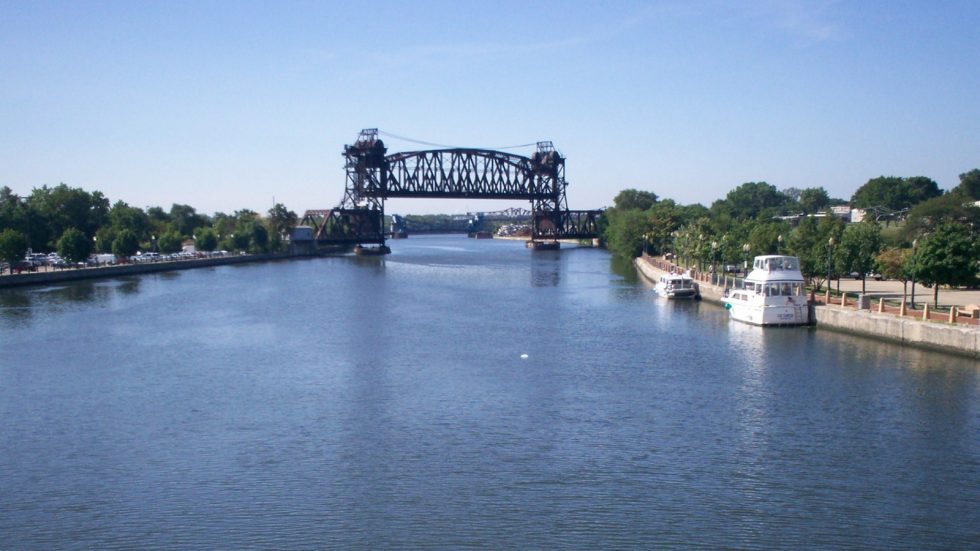A slight chop slapped against the 28-foot jonboat’s hull as we left the lee of the recessional moraine between the upper and lower lakes. Gusty west winds swept down valley, but the morning sun was warm, and we caught tantalizing glimpses of bluebird skies through the scattered cloud cover.
“The glacier was about 800 to 900 feet thick, and as it inched its way eastward, it left these huge moraines,” Jim continued. “The boulders were its teeth; they did all the carving. It’s amazing, how anything could move that much dirt. These are the largest glacial lakes in the state.”
Staring at the massive banks of rocks and sediment deposited by a long-gone river of ice, I inhaled the freshwater breath of the 10,000-year-old lake and heard an errant seagull’s cry. In a way, this could be an inland lake in my native Midwest. But then I looked higher, and honestly, it couldn’t be anywhere but Colorado.
Towering 13,000-foot peaks surround Twin Lakes Reservoir. Among these giants is granddaddy Mount Elbert — at 14,433 feet, it’s the highest summit in the Rocky Mountains and the second-highest peak in the contiguous United States (only California’s Mount Whitney is taller).
The 2,700-acre reservoir lies in Elbert’s shadow at 9,200 feet, 15 miles south of the exquisitely preserved mining community of Leadville and 36 miles from tony Aspen via State Highway 82. Just beyond the naturally formed lakes, 82 snakes upward to Independence Pass at 12,095 feet and then descends into Aspen; it’s the highest paved Continental Divide crossing in the country.
It simply doesn’t get more “Rocky Mountain High” than this.
Colorado Riches
Hardcore boaters usually find themselves in Colorado for one of two reasons. Either they’re just passing through, or they’re on vacation doing decidedly un-boater-y things like hiking a Fourteener or visiting one of the Centennial State’s four national parks.
They’re likely not indulging their passion here, but they should be. Turns out, Colorado is a boating state. A 2013 National Marine Manufacturers Association (NMMA) study revealed that Colorado has more than 95,000 recreational boats (72 percent of which are powerboats), and state residents spend $360.5 million each year on boating-related products and activities. The total economic impact of the boating industry here is a cool $850.2 million.
Where is everyone going? Colorado is home to more than 2,000 navigable lakes, from Denver-area hotspots like Chatfield and Cherry Creek reservoirs, to prairie oases such as Fort Morgan’s Jackson Lake, to high mountain jewels like Lake County’s Twin Lakes.
Lake County has been a hot destination since the mid-19th century, when prospectors came to seek their fortunes in the Pikes Peak Gold Rush. The silver boom kicked off in the late 1870s with the discovery of valuable silver-lead deposits, and Leadville became one of the world’s richest silver camps. Men like Horace Tabor, James Joseph “J.J.” Brown (husband of Margaret “the Unsinkable Molly” Brown), James V. Dexter and John Francis Campion became mining royalty.

The nearby mountain village of Twin Lakes was founded in 1879. The Denver and Rio Grande Railroad brought newcomers to Twin Lake Station; from there, they easily could travel north to booming Leadville or over the pass to Aspen. Some decided to stay.
By the 1880s, tourists outnumbered the miners on the trains. Wagons, yachts and steam launches carried genteel Victorian guests to summer homes and hotels. One of the most famous was the Interlaken Resort, which got its start as the Lakeside Hotel in 1879. Mining millionaire James V. Dexter purchased it in 1883 and created a luxurious resort community for the wealthy. It would survive until the turn of the 20th century — and find new life decades later as a San Isabel National Forest destination.
Enter Jim and Lexie McMillan.
Boating Experts at 9,200 Feet
We couldn’t have predicted that we would meet two U.S. Coast Guard-licensed captains nearly two miles high in the Rockies, offering boat tours to the old resort. Then we found Twin Lakes Interlaken Boat Tours’ little white tent near the White Star Campground on the upper lake’s north shore, and we met the McMillens.
Born and raised in Wyoming, Jim served in the U.S. Navy and worked in the offshore supply business. He also is an accomplished sailor and earned a variety of racing trophies with his Catalina 22.
His wife, Lexie, is from east Texas. She became the first female student at the National River Academy in Arkansas, earned her pilot’s license for the Mississippi and Ohio rivers, and stood at the helm of celebrated riverboats such as the Delta Queen.
The couple ran boat tours in Texas for 15 years before moving to Colorado, and they are now in their third season as a U.S. Forest Service concessionaire at Twin Lakes. Their two-hour boat tours aboard Molly Brown provide a real insider’s look at the lakes.
We clambered across the jonboat’s boarding ramp at 10 a.m., and Lexie hauled in the ramp with a clever pulley system. Once under way, Jim talked glaciers. And fishing.
“Right now, the trout are harder to catch because of all the nutrients in the water rushing out of the mountains,” he noted. “But this is a big fishing area for mackinaw (lake), rainbow and brown trout.”
While hand-carried vessels such as canoes and kayaks can launch from a variety of spots, there is only one ramp for launching a trailerable powerboat, and that’s on the lower lake. The state has mandatory inspections for zebra mussels.
If anglers are planning to fish from shore, the best spots are along the sandbars and channels near the dam. The Mount Elbert Power Plant, on the lower lake’s north shore, is another option. The turbines do quick work of chumming any unfortunate fish from the Mount Elbert Forebay Reservoir 800 feet above, creating a prime lower-lake honey hole.
“It’s a pump-back power station,” Jim cautioned. “You have to be careful, because the in-and-out causes lake fluctuations. That can leave boaters high and dry if they’re anchored too close to shore. You have to watch the current in the cut, too.”
The Interlaken Resort District
Roughly 40 minutes after our departure, Molly Brown ghosted into the beach along the lower lake’s south shore, and Lexie lowered the gangplank once again. We were here.
The Interlaken Resort District is the only location on the National Register of Historic Places that doesn’t have a parking lot. It’s only reachable by boat, or via a 2.5-mile trip along the famous Colorado Trail (hike, mountain bike or ride a horse, take your pick). Once upon a time, however, well-heeled guests arrived by wagon road to enjoy a lakeside summer filled with pleasant diversions like live music, dancing, billiards, horseback riding, hunting and fishing.

Eight buildings remain, including the original two-story hotel, two granaries, a horse stable, the resort laundry, a six-bedroom hotel annex, its accompanying six-sided privy and a gemlike, nautical-style cabin that Dexter built for his family in 1895.
“They had running water and electricity out here,” Lexie told us as we strolled the shady, silent grounds. “There was a 30-foot cutter yacht named Dauntless, a 50-foot steamboat, even a dance pavilion.”
“It was a quiet, exclusive resort, with many notable visitors, including Teddy Roosevelt,” Jim added.
Sadly, the glory days were short-lived. The pavilion burned down, the steamboat sank, and damming and dredging during the original reservoir project knocked out the bridge and flooded the road.
Dexter died in 1899, and Interlaken died with him. There are conflicting reports, but it seems the hotel served as a boarding house until the 1930s and then fell into disrepair.
Thanks to donor support and countless volunteer hours, the property has been undergoing restoration work since 1979. All remaining buildings have new roofs, and the hotel and Dexter Cabin were moved farther back from high-water line following the 1978 dam project.
Today, the resort reveals just traces of its former glory. And it serves as a haunting reminder of what once was.
“There were lots of hotels, resorts, marinas and docks before the 1970s,” Jim said. “Now, it’s very quiet.”
Twin Lakes Ghosts
There is definitely a peacefulness about Twin Lakes. Yes, it’s part of a national forest, but there’s something more.
Cruising back across the lower lake, we looked back to see the sightless, boarded-up Interlaken Hotel fade into the towering pines. We nosed through the cut that was a rushing creek in the years before the dams, and we passed below the moraine that once was home to the Campion Hotel. Here, rusting pipes and a scattering of melted glass, broken pottery, nails and scorched brickwork are all that remain of John F. Campion’s elegant summer villa, which burned in the 1920s.
As it turns out, ghosts are very much part of the Twin Lakes boating experience. When you drive the roughly 40 miles south of I-70, pass through Leadville, and embark on this high-country boating adventure, you’ll enter another world. One filled with achingly old mountains, faint glacial footprints, and the echoes of steamboats, summer resorts and a bygone era.
Author: Heather Steinberger is a contributor to HeartLand Boating
Photos: Richard Steinberger
RESOURCES
Vacation Planning
To review your lodging and dining options in the Leadville-Twin Lakes area, and to learn more about recreational activities and special events, visit:
www.visittwinlakes.com
www.leadvilletwinlakes.com
www.leadville.com
San Isabel National Forest Camping
Campsites at the Dexter, Parry Peak and Twin Peaks campgrounds are available on a first-come, first-serve basis. You can reserve some sites at Lake View and White Star campgrounds through www.recreation.gov. Dispersed camping also is available in the area.
Twin Lakes Interlaken Boat Tours
Tours run daily, 10 a.m. and 1 p.m., May through September. www.twinlakesinterlakenboattours.com
Boat Rentals
You can rent kayaks, canoes, SUPs, a Hobie sailboat, a PWC and fishing boats at Twin Lakes Canoe & Kayak Adventures. The company also offers tours. www.twinlakescanoeandkayak.com




